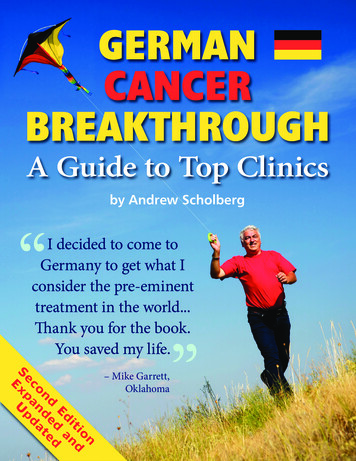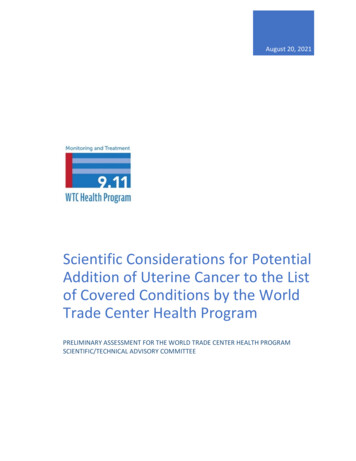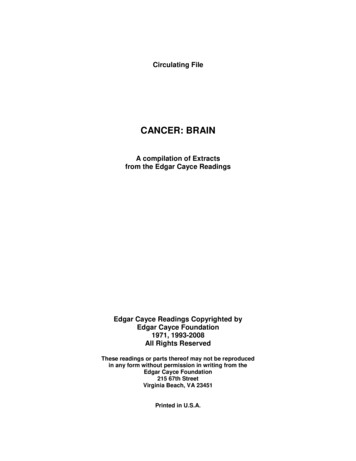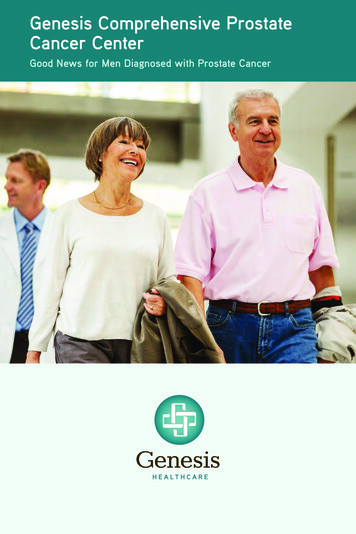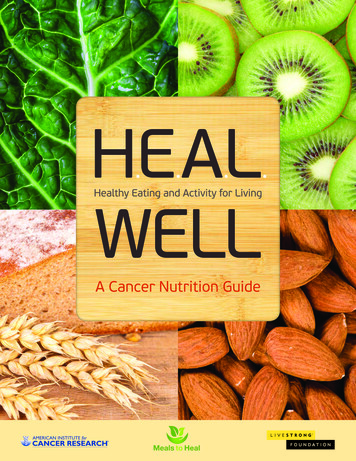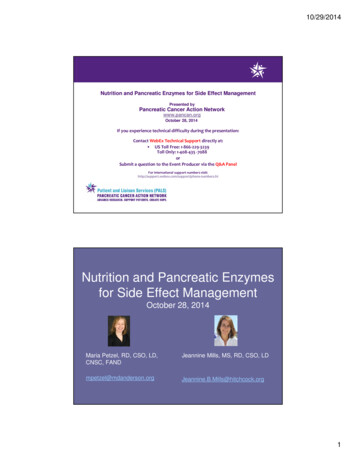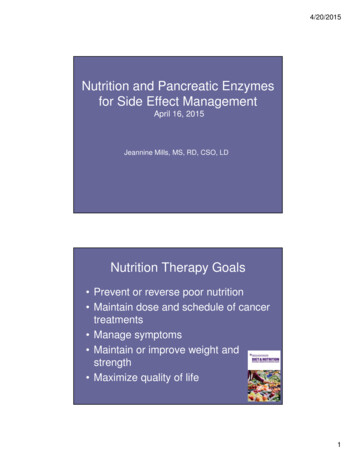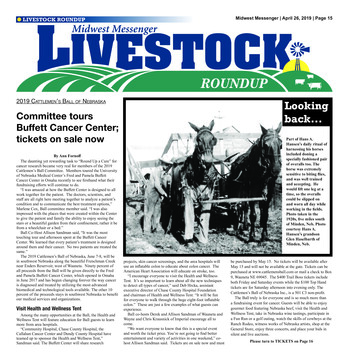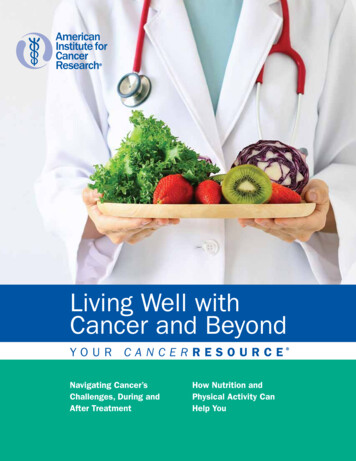
Transcription
Living Well withCancer and BeyondY O U R C A N C E R R E S O U R C E Navigating Cancer’sHow Nutrition andChallenges, During andPhysical Activity CanAfter TreatmentNavigating Cancer’s Help YouHow Nutrition andChallenges, During andAfter TreatmentPhysical Activity CanHelp You
About AICRThe American Institute for Cancer Research (AICR) is the cancer charity that fosters research onthe relationship of nutrition, physical activity and weight management to cancer risk, interpretsthe scientific literature and educates the public about the results. It funds innovative researchconducted at universities, hospitals and research centers across the country. AICR has publishedthree landmark reports that interpret the accumulated research in the field, and is committed toa process of continuous review. AICR also provides a wide range of educational programs to helpmillions of Americans learn to make dietary changes for lower cancer risk. Its award-winning NewAmerican Plate is presented in brochures, seminars and on its website, www.aicr.org.AICR is a member of World Cancer Fund International that leads a network of cancer charitiesconsisting of: the American Institute for Cancer Research (AICR); World Cancer Research Fund(UK); and World Cancer Research Fund Netherlands (WCRF NL).AICR CancerResource Advisory CommitteeThe CancerResource Advisory Committee has provided invaluable expert guidance in thedevelopment of this guide, helping to ensure that the resource provides state-of-the-art informationto ease the way for those facing cancer and its treatment.Committee Members Claudio Battaglini, PhD, Lineberger Comprehensive Cancer Center, UNC Chapel Hill Mandi Pratt Chapman, MA, GW Cancer Institute Community Programs Elizabeth Hatcher, RN, BSN, GW Cancer Institute Lee W. Jones, PhD, Duke Center for Cancer Survivorship Marcelle Kaplan, RN, MS, AOCN, CBCN, Oncology Nursing Society Francis Keefe, PhD, Duke University Medical Center Lidia Schapira, MD, Massachusetts General Hospital Cheri Van Patten, RD, MSc, BC Cancer Agency, Vancouver, BCAMERICAN INSTITUTE FOR CANCER RESEARCH
Table of Contents1Looking Forward with Hope: Your CancerResource . . . . . . . . . . . . . . . 42During Treatment: Healthy Eating . . . . . . . . . . . . . . . . . . . . . . . . . . . . . 6How to Use CancerResource . . . . . . . . . . . . . . . . . . . . . . . . . . . . . . . . . . . . . 4Cancer Survival Is Increasing . . . . . . . . . . . . . . . . . . . . . . . . . . . . . . . . . . . . . . 4iTHRIVE Plan. . . . . . . . . . . . . . . . . . . . . . . . . . . . . . . . . . . . . . . . . . . . . . . . . . 57 Keys to Making Healthy Changes That Last . . . . . . . . . . . . . . . . . . . . . . . . . . 55 Tips for Healthy Eating on a Budget . . . . . . . . . . . . . . . . . . . . . . . . . . . . . . . . 6Dealing with the Common Side Effects of Cancer Treatments . . . . . . . . . . . . . . . 7Fatigue . . . . . . . . . . . . . . . . . . . . . . . . . . . . . . . . . . . . . . . . . . . . . . . . . . . 7Loss of Appetite, Weight Loss, Reduced Muscle Mass and Undernutrition . . . 7Weight Gain . . . . . . . . . . . . . . . . . . . . . . . . . . . . . . . . . . . . . . . . . . . . . . . . 8Fluid Retention . . . . . . . . . . . . . . . . . . . . . . . . . . . . . . . . . . . . . . . . . . . . . 8Nausea . . . . . . . . . . . . . . . . . . . . . . . . . . . . . . . . . . . . . . . . . . . . . . . . . . . 9Vomiting . . . . . . . . . . . . . . . . . . . . . . . . . . . . . . . . . . . . . . . . . . . . . . . . . . 9Diarrhea . . . . . . . . . . . . . . . . . . . . . . . . . . . . . . . . . . . . . . . . . . . . . . . . . 10Constipation . . . . . . . . . . . . . . . . . . . . . . . . . . . . . . . . . . . . . . . . . . . . . . 10Feeling Full Quickly . . . . . . . . . . . . . . . . . . . . . . . . . . . . . . . . . . . . . . . . . 11Taste Changes . . . . . . . . . . . . . . . . . . . . . . . . . . . . . . . . . . . . . . . . . . . . 11Milk or Lactose Intolerance . . . . . . . . . . . . . . . . . . . . . . . . . . . . . . . . . . . 12Food Aversion . . . . . . . . . . . . . . . . . . . . . . . . . . . . . . . . . . . . . . . . . . . . . 12Sore Mouth, Tongue and Throat . . . . . . . . . . . . . . . . . . . . . . . . . . . . . . . . 13Dry Mouth . . . . . . . . . . . . . . . . . . . . . . . . . . . . . . . . . . . . . . . . . . . . . . . 14Difficulty Swallowing . . . . . . . . . . . . . . . . . . . . . . . . . . . . . . . . . . . . . . . . . 14Stricture . . . . . . . . . . . . . . . . . . . . . . . . . . . . . . . . . . . . . . . . . . . . . . . . . 15Tooth Decay . . . . . . . . . . . . . . . . . . . . . . . . . . . . . . . . . . . . . . . . . . . . . . 15Questions to Ask Your Health Practitioner or DietitianW About Nutrition During Treatment . . . . . . . . . . . . . . . . . . . . . . . . . . 164 Tips for Keeping Food Safe . . . . . . . . . . . . . . . . . . . . . . . . . . . . . . . . . . . . . 17WCancerResource: Table of Contents1 WorksheetAMERICAN INSTITUTE FOR CANCER RESEARCH
3During Treatment: Getting and Staying Active . . . . . . . . . . . . . . . . . . 184After Treatment: Healthy Eating . . . . . . . . . . . . . . . . . . . . . . . . . . . . . 225After Treatment: Getting and Staying Active . . . . . . . . . . . . . . . . . . . 286Cancer and Its Treatment: General Information . . . . . . . . . . . . . . . . . 32Benefits of Being Active . . . . . . . . . . . . . . . . . . . . . . . . . . . . . . . . . . . . . . . . . 18How Exercise Can Help You Deal with CommonTreatment Side Effects . . . . . . . . . . . . . . . . . . . . . . . . . . . . . . . . . . . . . . . . . . 19Fatigue . . . . . . . . . . . . . . . . . . . . . . . . . . . . . . . . . . . . . . . . . . . . . . . . . . 19Weight Loss . . . . . . . . . . . . . . . . . . . . . . . . . . . . . . . . . . . . . . . . . . . . . . 19Weight Gain . . . . . . . . . . . . . . . . . . . . . . . . . . . . . . . . . . . . . . . . . . . . . . . 20Difficulty Sleeping . . . . . . . . . . . . . . . . . . . . . . . . . . . . . . . . . . . . . . . . . . 20Cardiovascular Damage (Cardiotoxicity) . . . . . . . . . . . . . . . . . . . . . . . . . . . 21Getting Started . . . . . . . . . . . . . . . . . . . . . . . . . . . . . . . . . . . . . . . . . . . . . . . 21AICR Cancer Prevention Recommendations . . . . . . . . . . . . . . . . . . . . . . . . . . . 22The New American Plate . . . . . . . . . . . . . . . . . . . . . . . . . . . . . . . . . . . . . . . . . 23Serving Sizes Matter . . . . . . . . . . . . . . . . . . . . . . . . . . . . . . . . . . . . . . . . . . . 24Healthy or Harmful? . . . . . . . . . . . . . . . . . . . . . . . . . . . . . . . . . . . . . . . . . . . . 25Are Dietary Supplements Good Substitutes for Nutrients in Food? . . . . . . . 25What About Phytochemical Supplements? . . . . . . . . . . . . . . . . . . . . . . . . . 25Can a Macrobiotic Diet Prevent Disease? . . . . . . . . . . . . . . . . . . . . . . . . . 25Should I Only Eat Organic Foods? . . . . . . . . . . . . . . . . . . . . . . . . . . . . . . . 26Are Soy Foods in Moderation Safe? . . . . . . . . . . . . . . . . . . . . . . . . . . . . . 26Will a Vegetarian Diet Protect Me? . . . . . . . . . . . . . . . . . . . . . . . . . . . . . . 26Does Sugar Feed Cancer? . . . . . . . . . . . . . . . . . . . . . . . . . . . . . . . . . . . . 26Should I Take Fiber Supplements? . . . . . . . . . . . . . . . . . . . . . . . . . . . . . . 26Should I Follow a Ketogenic Diet? . . . . . . . . . . . . . . . . . . . . . . . . . . . . . . . 26Evaluating Nutrition Information . . . . . . . . . . . . . . . . . . . . . . . . . . . . . . . . . . . 27Be Informed . . . . . . . . . . . . . . . . . . . . . . . . . . . . . . . . . . . . . . . . . . . . . . . . . 27The Role of Weight . . . . . . . . . . . . . . . . . . . . . . . . . . . . . . . . . . . . . . . . . . . . . 29Overweight? . . . . . . . . . . . . . . . . . . . . . . . . . . . . . . . . . . . . . . . . . . . . . . 30Underweight? . . . . . . . . . . . . . . . . . . . . . . . . . . . . . . . . . . . . . . . . . . . . . 30Get F.I.T.T. . . . . . . . . . . . . . . . . . . . . . . . . . . . . . . . . . . . . . . . . . . . . . . . . . . . 30Explore a Variety of Physical Activities . . . . . . . . . . . . . . . . . . . . . . . . . . . . . . 31What Is Cancer? . . . . . . . . . . . . . . . . . . . . . . . . . . . . . . . . . . . . . . . . . . . . . . 32Understanding Your Diagnosis . . . . . . . . . . . . . . . . . . . . . . . . . . . . . . . . . . . . 33Questions to Ask Your Health-Care ProviderW About Your Diagnosis . . . . . . . . . . . . . . . . . . . . . . . . . . . . . . . . . . . 34Finding a Doctor and Health-Care Team . . . . . . . . . . . . . . . . . . . . . . . . . . . . . . 35Questions to Ask Your OncologistW About Your Treatment . . . . . . . . . . . . . . . . . . . . . . . . . . . . . . . . . . . 36WCancerResource: Table of Contents2 WorksheetAMERICAN INSTITUTE FOR CANCER RESEARCH
Introduction to Treatment Options . . . . . . . . . . . . . . . . . . . . . . . . . . . . . . . . . . 37Surgery . . . . . . . . . . . . . . . . . . . . . . . . . . . . . . . . . . . . . . . . . . . . . . . . . . 37Radiation Therapy . . . . . . . . . . . . . . . . . . . . . . . . . . . . . . . . . . . . . . . . . . 37Chemotherapy . . . . . . . . . . . . . . . . . . . . . . . . . . . . . . . . . . . . . . . . . . . . . 37Hormone Therapy . . . . . . . . . . . . . . . . . . . . . . . . . . . . . . . . . . . . . . . . . . 38Targeted Therapies . . . . . . . . . . . . . . . . . . . . . . . . . . . . . . . . . . . . . . . . . 38Integrative Medicine . . . . . . . . . . . . . . . . . . . . . . . . . . . . . . . . . . . . . . . . 39Treatment Side Effects . . . . . . . . . . . . . . . . . . . . . . . . . . . . . . . . . . . . . . . . . . 39Hair Loss . . . . . . . . . . . . . . . . . . . . . . . . . . . . . . . . . . . . . . . . . . . . . . . . 39Fatigue . . . . . . . . . . . . . . . . . . . . . . . . . . . . . . . . . . . . . . . . . . . . . . . . . . 397Conclusion . . . . . . . . . . . . . . . . . . . . . . . . . . . . . . . . . . . . . . . . . . . . 408Glossary . . . . . . . . . . . . . . . . . . . . . . . . . . . . . . . . . . . . . . . . . . . . . . 42Useful Resources . . . . . . . . . . . . . . . . . . . . . . . . . . . . . . . . . . . . . . . . . . . . . 41American Institute for Cancer Research . . . . . . . . . . . . . . . . . . . . . . . . . . 41Academy of Nutrition and Dietetics . . . . . . . . . . . . . . . . . . . . . . . . . . . . . . 41American Cancer Society . . . . . . . . . . . . . . . . . . . . . . . . . . . . . . . . . . . . . 41American Society of Clinical Oncology . . . . . . . . . . . . . . . . . . . . . . . . . . . . 41Healthfinder . . . . . . . . . . . . . . . . . . . . . . . . . . . . . . . . . . . . . . . . . . . . . . 41iTHRIVE Plan . . . . . . . . . . . . . . . . . . . . . . . . . . . . . . . . . . . . . . . . . . . . . . 41MEDLINEplus . . . . . . . . . . . . . . . . . . . . . . . . . . . . . . . . . . . . . . . . . . . . . 41National Cancer Institute . . . . . . . . . . . . . . . . . . . . . . . . . . . . . . . . . . . . . 41OncoLink . . . . . . . . . . . . . . . . . . . . . . . . . . . . . . . . . . . . . . . . . . . . . . . . . 41CancerResource: Table of Contents3AMERICAN INSTITUTE FOR CANCER RESEARCH
1Looking Forwardwith HopeYO U R C A N C E R R E S O U R C E There has never been a time of greater hope for those with cancer.Today, we know more about identifying and treating this disease thanever before, and patients now have a much better chance to overcomecancer and return to an active and full life.Many difficult decisions must be made bythose facing cancer, both during treatmentand afterward, when survivors are focusedon improving their quality of life whilereducing their chances of recurrence andsecondary cancers. CancerResource describes the steps that can help youachieve these goals.How to UseCancerResource Many factors have been shown to affectcancer risk, including diet, physical activityand weight. AICR’s mission relates to theseissues and CancerResource providesspecific recommendations about eatingand physical activity during and after yourcancer treatment.But CancerResource also takes a morecomprehensive approach to cancer caredecisions. At the end of this booklet, you willfind information about cancer, the treatmentoptions available to you and worksheets withquestions to ask your health-care providers.For those who want more information,additional sources of information are listedthroughout this guide. At the end of thisCancerResource: Looking Forward with HopeCANCER SURVIVALIS INCREASINGThe current statistics from the National CancerInstitute show that: As of January 2019, it is estimated that thereare 16.9 million cancer survivors in the UnitedStates. T he number of cancer survivors is projected togrow to 26.1 million by 2040. I n 2019, 67% of survivors have survived5 years or more after diagnosis; 45% havesurvived 10 years or more; and 18% havesurvived 20 years or more. S ixty-four percent of survivors are currently65 years of age or older.4AMERICAN INSTITUTE FOR CANCER RESEARCH
resource, you will find a glossary of medical terms you might encounter during your cancer diagnosis,treatment and recovery.AICR developed CancerResource with the guidance of experts in a variety of medical, research andeducational areas. Every effort has been made to ensure that the information is as current andaccurate as possible, but the field of cancer research and treatment is constantly evolving.AICR also offers the iTHRIVE Plan that can help patients focus on several wellness strategies to helpthem heal from treatment, reduce risk of recurrence and achieve optimal wellness.Personalize your health and wellnessthrough the iTHRIVE Plan.Join iTHRIVE to become proactive about your health today. This online program lets survivorscreate personalized, physician-approved wellness plans centered around five health pillars(diet, movement, environment, rejuvenation and spirit) and turns scientific information intofun, actionable activities.Visit https://www.aicr.org/cancer-survival/ithrive/ to join for free.7 KEYS TO MAKING HEALTHY CHANGES THAT LAST1. F ocus on individual changes. As you read CancerResource ’s advice about eating well andbeing active during and after treatment, remember you don’t need to make drastic changesovernight. Studies show that choosing one or two behaviors to work on helps make thosechanges stick. For example, start off by resolving to increase the amount of plant foods on yourdinner plate tonight or adding five minutes to your daily activity tomorrow.2. A sk for help. Your doctor can refer you to a registered dietitian (RD) and a certified exercisephysiologist. They can help you focus on making those healthy changes that will make thebiggest difference in how you are coping with cancer.3. Go public. Set a specific goal for behavior change and tell others about it. “I am going to take abrisk walk every day in the early afternoon.”4. R ecord each behavior you are changing so you can track your progress over time and makeadjustments in your plan, such as readjusting your goal if it is too high or too low. Again, an RDand a certified exercise specialist can help monitor your progress.5. Reward yourself. Give yourself something you really enjoy when you reach milestones along theway to your goal.6. Accept setbacks. When attempting to make healthy changes to your diet or activity level,setbacks will occur. Develop a plan for anticipating and dealing with setbacks so you can workthrough them. Getting back on track after a setback is one of the most important steps in abehavior change program.7. Be patient with yourself and your progress. Remember: Changing behavior takes time. Bymaking gradual changes you are much more likely to stay on track in the long run.The general information in CancerResource may not apply to your individual situation, and AICR is not responsible for anymisinterpretation or misapplication of included information.CancerResource is an information resource, not a substitute for medical care.CancerResource: Looking Forward with Hope5AMERICAN INSTITUTE FOR CANCER RESEARCH
During TreatmentH E A LT H Y E AT I N GFor someone facing the demands of cancer treatment, eating healthyprovides nutrients that can fuel the body and aid in healing and alsohelp in maintaining a healthy weight.Special nutritional challenges are bound to arise throughout treatment because the side effectsof therapies can result in changes in your eating habits and differences in the way your body usesnutrients. Nutritional needs and eating habits are affected differently depending on the type ofcancer and its treatment.This section focuses on suggestions for managing common eating difficulties during cancer—specifically, reduced appetite, weight loss and undernutrition; weight gain; fluid retention; nausea;vomiting; diarrhea; constipation; feeling full quickly; taste changes; milk or lactose intolerance; foodaversion; sore mouth, tongue and throat; dry mouth; difficult swallowing; stricture (narrowing of theesophagus); fatigue; and tooth decay. Sources for more detailed information from AICR and othertrustworthy organizations are also listed.Many of the tips and food suggestions in this section are based on the fact that the side effectslisted above may make it difficult to eat a healthy, balanced diet sufficient to maintain weight. As aresult, some of the suggested foods are higher in calories and are recommended temporarily to keepup your energy and prevent weight loss during treatment. Note, however, that if you are a woman withbreast cancer (or are taking certain medications), unwanted weight gain can occur during treatment(see page 8). If this is a concern for you, it may help to adjust your calorie intake to maintain ahealthy weight.5 TIPS FOR HEALTHY EATING ON A BUDGET1. M ake a shopping list and stick to it. Utilize grocery store circularsfor sale items, clip coupons or participate in free grocery store pickup programs to minimize impulse buys.2. Opt for water, tea and coffee over expensive soda and fruit punch.3. E at more meatless meals that feature beans and other plantproteins.4. Ditch snack bars and candy bars for a piece of your favorite fruit.5. Turn leftovers into hearty soups you can enjoy over several days.CancerResource: During Treatment6AMERICAN INSTITUTE FOR CANCER RESEARCH
Dealing with the Common Side Effects of Cancer TreatmentsFatigueFatigue is the most common side effect in those undergoing cancer treatment. For some, fatiguemay continue after treatment ends. It can significantly affect your quality of life and make it difficultto prepare and eat nourishing meals.THESE S TE P S M AY H E LP Make meal preparation easier: Participate in free grocery store pick-up programs to eliminate the need to grocery shopor get a membership to a grocery store home delivery service.Temporarily rely on convenience products like ready-to-eat foods; frozen dinners; frozenor canned fruits and vegetables; prepared pasta sauces; and instant rice. Check labelsfor healthful choices—low in sodium and high in protein and fiber.Keep healthy snacks on hand. Examples are dried fruits, cheese on whole-graincrackers and graham crackers.Prepare food when you’re feeling best. Prepare large quantities of your favorite mealsand freeze leftovers in meal-size portions. Make blended fruit and yogurt shakes thatcan be kept in the refrigerator. et help with meals from friends and family members. Phone for restaurant delivery orGcarry-out or have meals delivered by a service such as Meals on Wheels. ry to get regular physical activity. Strong, consistent evidence shows that regularTactivity can relieve fatigue and also enhance mood and appetite. See more under “DuringTreatment: Getting and Staying Active.”There are many different causes of fatigue including depression and difficulty sleeping. Talk toyour doctor about your fatigue, and any other related symptoms, to determine if you’d benefitfrom treatments.Loss of Appetite, Weight Loss, Reduced Muscle Mass and UndernutritionWeight loss and undernutrition are common among cancer patients due to loss of appetite and otherfactors that affect eating. When severe, these issues can lower your quality of life and interfere withthe functioning of important body organs such as the heart, liver and kidneys. It can also slow yourbody’s ability to heal from surgery or radiation-induced tissue burns and infection.THESE S TE P S M AY H E LP Eat several small meals a day instead of three large meals.Eat high-protein foods first in your meal while your appetite is strongest—foods such asbeans, chicken, fish, meat, yogurt and eggs.Eat your largest meal when you feel hungriest, whether that’s at breakfast, lunch or dinner.Keep food interesting—whether by changing up recipes and seasonings or eating in anice restaurant.Keep favorite foods and high-calorie foods and beverages around the house or yourenvironment during the day.CancerResource: During Treatment7AMERICAN INSTITUTE FOR CANCER RESEARCHHEALTHY EATING DURING TREATMENTThese tips and resources are not substitutes for speaking with your health practitioner. He orshe can address your individual eating challenges and may refer you to a registered dietitian whospecializes in nutritional care during cancer treatment.
Weight GainYou may also be gaining weight because of fluid retention; if you are, see below. Tell your doctorabout excess weight, especially if you gain weight rapidly over just a few days, so the cause canbe identified.THESE STE P S M AY HE LP Concentrate on healthy foods such as vegetables, fruits, whole grains and beans andother foods that are naturally low in calories and high in fiber to help you feel full. Pay attention to portion sizes, checking food labels and the serving sizes listed. Love what you eat. Include and savor foods that you enjoy most so you feel satisfied. Eat only when you’re hungry. Consider psychological counseling or medications if youfind yourself eating to address feelings of stress, fear or depression, and try to findalternatives to eating out of boredom.Try to get regular physical activity, which can help manage your weight and relieve yourfatigue. (See “During Treatment: Getting and Staying Active” section.)Fluid RetentionWhen patients gain weight during treatment without eating extra calories, the weight increase maybe due to edema, or swelling. Certain common drugs such as prednisone and gabapentin can causethe body to retain too much fluid, as can a nutritional deficiency. Tell your health practitioner aboutrapid weight gain so he or she can determine the cause.THESE STE P S M AY HE LP Drink plenty of water unless you have been specifically advised by your doctor tolimit fluids.Eat less salt and foods with less sodium such as fresh or frozen fruits and vegetablesand unsalted or reduced-sodium snacks and soups. Replace processed foods such ascold cuts, which can be high in sodium, with alternatives. Stay as physically active as possible. Elevate your legs when resting. If needed, your physician can prescribe medications to minimize fluid retention.CancerResource: During Treatment8AMERICAN INSTITUTE FOR CANCER RESEARCHHEALTHY EATINGWeight gain is commonly seen during treatment of breast and certain other cancers, in womenundergoing hormonal therapies or as a result of “induced/early menopause” from chemotherapy.While the exact causes are not known, weight gain may result in part from a change in diet andexercise routines, such as eating more due to stress or to control nausea and being less active dueto fatigue. If steroids are part of your cancer treatment, they can be powerful appetite stimulants.DURING TREATMENTIf you are not consuming enough calories and protein leading to loss of muscle mass and bodyweight, ask your health-care team for simple, high calorie, easy-to-digest recipes like smoothies andmilkshakes or suggestions for liquid or powdered commercial nutritional supplements. If you arestill unable to consume enough calories and protein, you may benefit from tube feeding. A feedingtube is placed into the stomach and is used to administer a nutritional formula into the digestivetract reducing or eliminating the need to consume food through the mouth. During times when thedigestive tract is not working effectively, total parenteral nutrition (TPN) may be appropriate. TPNprovides nutrients directly into a vein. TPN is generally used as a last resort because of the cost andpotential side effects.
Nausea is a common side effect of cancer treatment. It can sometimes be accompanied by vomiting(see below). Anticipation of a treatment session can cause nausea in some cases.THESE STE P S M AY HE LP Eat foods at room temperature or cooler, as hot food canaggravate nausea because of strong odors.Eat sitting up, and rest sitting up or reclined with your headraised for about an hour after eating.Drink beverages between meals instead of with a meal.Drink beverages cool or chilled and sip through a straw.Rinse out your mouth before and after eating, and suck ona hard candy such as peppermint or lemon if you have a badtaste in your mouth.Avoid triggers where possible by recognizing times, foods,smells or events that trigger your nausea and trying tochange your schedule or diet to avoid them.If the smell of food or cooking nauseates you, try tokeep the room well-ventilated; prepare meals that don’trequire cooking; ask others to cook your meals for youor have meals delivered from Meals on Wheels or othersimilar services.FOODS TO TRYToast and crackers, yogurt,sherbet, Popsicles, pretzels,angel food cake, cannedfruits (peaches, pears, fruitcocktail), skinned chicken(baked, boiled), oatmeal,brothsFOODS TO AVOIDAny food that’s fatty, greasy,fried, spicy, very sweet or hasa strong odorFor nausea from radiation therapy or chemotherapy, eat bland, soft foods on treatmentdays and avoid eating for an hour or two before treatment. If you find that the anticipationof treatment causes nausea, practice relaxation or meditation techniques or anotheractivity to distract yourself.Discuss the use of anti-nausea medications with your doctor.VomitingVomiting can follow nausea and can be brought on by some cancer treatments. Other factors canmake vomiting worse such as food odors, gas in the stomach or motion. Vomiting may occur withoutassociated nausea. Tell your doctor if you have persistent vomiting and cannot keep liquids down. Itis important to prevent dehydration if you are vomiting.THESE STE P S M AY HE LP Sit upright and bend forward after vomiting. Don’t eat or drink until your vomiting is controlled. Once vomiting is under control, try drinking small amounts of clear liquids. Examples:cranberry juice, cool broth or flat soda (carbonated beverages can lead to vomiting insome people).Try eating small amounts of soft foods such as Cream of Wheat, pudding, frozen yogurt orgelatin when you are able to keep down clear liquids. And gradually work your way back toyour regular diet.CancerResource: During Treatment9AMERICAN INSTITUTE FOR CANCER RESEARCHHEALTHY EATING Eat small amounts of food often and slowly instead of largemeals. If nausea in the morning is a problem, keep crackersand soda at your bedside to nibble on before getting up.DURING TREATMENTNausea
Diarrhea is another side effect that can be caused bycancer treatment, including chemotherapy and othermedications, radiation therapy to the abdomen andsurgery. Other potential causes include infection,food sensitivity and emotional upset. Call your healthpractitioner if you have severe or long-term diarrhea,which may cause dehydration, nutrient loss and otherhealth problems. Medications may be helpful.THESE STE P S M AY HE LP Eat small amounts of food throughout the dayrather than three large meals.Rice, noodles, hard-boiled eggs,bananas, puréed vegetables,applesauce, yogurt, kefir, whitebread, skinnedturkey orchicken,fish, mashedpotatoesFOODS TO AVOIDRaw vegetables and fruits; high-fibervegetables like broccoli, corn, beans,cabbage, cauliflower and peas; onionsand strong spices; greasy, fatty or friedfoods; alcoholic beveragesSome doctors recommend temporarilyfollowing a “BRAT” plan—a low-fiber regimen featuring bananas, rice, apple sauce andtoast—but its effectiveness is currently being reexamined. Check with your doctor.ConstipationConstipation can result from some cancer treatments and pain medications. Constipation can alsohappen if you are not eating enough fiber or drinking enough fluids. Relying on tube feedings orphysical inactivity for extended periods of time can also cause constipation.THESE STE P S M AY HE LP Drink more liquids, aiming for at least eight 8-ounce glassesa day. Liquids can help keep stools soft. Good choicesinclude water, prune juice, warm juices, decaffeinated teasand hot lemonade.If you develop gas, limit certain foods. Culprit foods includebroccoli, cabbage, cauliflower, beans, cucumbers, onionsand carbonated drinks. Over-the-counter anti-gas productswith simethicone may help you avoid discomfort from thesefoods. Always check with your doctor before self-medicating,even with over-the-counter medications.FOODS TO TRYHigh-fiber vegetables likebroccoli, corn, beans,cabbage, cauliflower andpeas; whole-grain breadsEat a large breakfast, including a hot drink and high-fiberfoods (like hot or cold cereal, whole-wheat toast and fruit).Increase your physical activity, aiming for a walk or otherlimited exercise every day.Consider a fiber supplement, over-the-counter medicationssuch as stool softeners or laxatives if necessary. Always speak with your healthpractitioner first for specific guidance. (Remember to drink plenty of fluids with sucha supplement.)CancerResource: During Treatm
Cancer and Beyond. AMERICAN INSTITUTE FOR CANCER RESEARCH About AICR The American Institute for Cancer Research (AICR) is the cancer charity that fosters research on . (diet, movement, environment, rejuvenation and spirit) and turn


